Entries Tagged as '2010 Elizabeth'
September 21st, 2010 · 4 Comments
Maybe my perceptions are a bit skewed coming from Southern California – where it has been illegal to smoke in restaurants the longest and anyone who lights up is shot death glares from everyone within a ten-mile radius- but it seems to me that number of people who smoke in London is drastically higher than in the States.
I’ve lost count of the number of times I’ve been walking down the street only to have the person in front or to the side of me exhale their smoke directly into my path. I’ve had cigarette butts almost land on me as a smoker tosses it away multiple times. Again, maybe I’m particularly sensitive to this- not just because I come from California, but because I had severe asthma as a child, still am highly allergic to cigarette smoke, AND my mother spent almost 10 years teaching tobacco and drug education in the California public schools. So, I think it’s fair to say I’m pretty aware of smoking.
I’m making no personal judgements on smokers, but I just don’t understand how it can be so much more rampant here. At first I reasoned that maybe the UK’s tobacco education programs (if they have them at all) aren’t as widespread as they are in the States and California in particular but then I happened to notice the label on a discarded pack of ciggies, which looked a little something like this:
 [Photo: http://www.tobaccoonline.co.uk/images/products/1217200833339AMSobranie-Cocktail-cigarette.png]
[Photo: http://www.tobaccoonline.co.uk/images/products/1217200833339AMSobranie-Cocktail-cigarette.png]
I don’t make a habit of checking cigarette pack warning labels in the US, but I’m pretty sure that our warning labels use much smaller print and read something along the lines of: WARNING- cigarettes have been known to cause cancer and certain birth defects. But, no- the Brits put it right out there in big bold print- SMOKING KILLS. So why does such what seems to be a huge percent of London’s population continue to do it? There is a very weird disconnect here . . .
I actually did some research on this and, according to the London Health Observatory, “About 10 million adults in Great Britain smoke cigarettes – 23% of men and 21% of women” (http://www.lho.org.uk/LHO_Topics/National_Lead_Areas/Smoking.aspx#Smoking). However, data from the 2008 General Lifestyle Survey showed that, compared to other regions of England, London doesn’t actually have that high a percentage of smokers:
“The regions of England with the highest prevalence were the North West, and Yorkshire and the Humber, where 23 to 25 per cent of people were cigarette smokers (similar to the level in Scotland). The prevalence of cigarette smoking was lowest, at 19 per cent, in the East of England and in London”- http://www.statistics.gov.uk/downloads/theme_compendia/GLF08/GLFSmoking&DrinkingAmongAdults2008.pdf
I’m not trying to make a particular point here or offer any words of wisdom for London or Great Britain as a whole- I’m truthfully just amazed at how many people seem to smoke here. Looking at the statistics, though, makes it seem like London isn’t really that much of a smoker’s city.
So, I guess, what I’m asking is, what have been everyone else’s experiences? Am I just uber-sensitive? Are the statistics plain wrong? Maybe a little of both? Whatever the case may be, I really wish Londoners would stop blowing their smoke wherever they please and be a little more conscientious- some of us have delicate lungs! *cough*
Tags: 2010 Elizabeth
September 20th, 2010 · No Comments
Many of us have already talked ad nauseam about the rules governing Tube behaviour. No eye contact. All extremities and personal belongings to yourself. Never strike up a conversation with your fellow passengers (unless it is to moan about a delay or some noisome activity going on in a station).
However, we have also observed many exceptions to these rules, mostly in the form of young couples and Public Displays of Affection in varied locations and to varying degrees of intensity.
Beyond this, I have noticed that the LGBT community- particularly lesbian couples and cross-dressers/transgendered individuals- is extremely present here in London. As a group, they seem much more open and accepted here in London than some of the other cities I have been in. What the cause is, I don’t know- perhaps it has to do with the laws (I believe gay marriage is legal in England)? As someone who has and has had LGBT friends, I heartily applaud the apparent acceptance the community enjoys here.
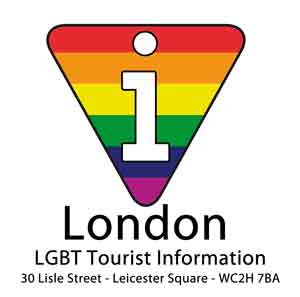 [From one of the LGBT London support sites: http://www.pinknews.co.uk/images/kulgbt.jpg]
[From one of the LGBT London support sites: http://www.pinknews.co.uk/images/kulgbt.jpg]
Anyway, as I was making my way back to the Arran House one day, I had an encounter with a lesbian couple that broke almost all the English rules of behaviour (not THAT kind of encounter . . . don’t get too excited, gentlemen)
I was transferring from one line to another and noticed two women in front of me holding hands and I remember thinking to myself “Awww, how sweet. I wonder if they’re sisters? Or . . . are they a couple?” While the TV show The L Word may be set in Los Angeles, I have not seen many gay couples – particularly lesbians- who feel comfortable enough to openly express affection in public.
We ended up in the same Tube car and the only open seat happened to be next to one of them. The other, a heavier woman, sat opposite and, within seconds of the doors closing had started fighting with the teenage girl sitting next to her (who, interestingly, looked and sounded to be foreign, not White-British). I quickly assessed the situation: both women were black, but the heavier one (who clearly was the femme in the relationship) was strongly taking on the Angry Black Woman persona while her partner (who was very butch) didn’t interfere except to say, “Do you have a problem with my girlfriend?” The butch lesbian was the one sitting next to me, so I turned to her girlfriend sitting across from me and asked if she wanted to switch seats with me so they could sit together. She seemed very surprised and pleased that I had offered but declined- I think she wanted to make the person sitting next to her uncomfortable for a little while longer (she said as much herself) and then leaned over and kissed her girlfriend next to me. As she continued arguing with her neighbour and generally drawing attention to herself, her girlfriend sitting next to me struck up a conversation, asking where I was from. As it turns out, she had visited the States once and stayed not 10 minutes from where I grew up! When the train got to their stop, both women took hands (the heavier one glaring daggers at her antagonist- frankly, I couldn’t decipher what the cause of contention was but it sounded like the issue had arisen from the woman’s size – maybe taking up too much seat room? – her race or her obvious sexual orientation) wished me a pleasant stay in England and departed.
After they got off the Tube, the girl who had been fighting with the heavier woman glanced at me suspiciously and then looked away. I’m still not certain what my crime was, that I was talking to people on the Tube at all, that those people were lesbians, or that they were black. Perhaps a combination of all three.
Since that incident, I have seen several more obviously-lesbian couples and some obviously-cross dressing or transgendered men walking around on the streets. From what I have observed and experienced, it seems to me that the gay community here is much more open, much more free about expressing affection and- as I experienced on the Tube- much more willing to break with the established rules of English social behaviour. And yet, the irony is there were still the restraints of other behavioural roles – the gay persona as well as the racial persona- coming into play. Perhaps the moral is that all people – English, American, black, white, gay, straight, whatever – are always adhering to some expected social code. We can reject some and embrace others but one is always present and guiding our public behaviour.
As a dedicated people watcher, I found this whole experience and the attention it made me pay to individual couples just fascinating. I tried very hard in my relation of it to use as netural and widely accepted terms as possible, hoping to cause no offense to anyone on any account.
Tags: 2010 Elizabeth
September 20th, 2010 · No Comments
About two weeks into our time here, I had a phone conversation with my mother that I found to be very interesting. I was going along and recounting some of my adventures when she interrupted me, saying “That’s great, Elizabeth, but don’t talk to any more English people.”
Puzzled, I asked, “What do you mean?”
“I can barely understand you as it is!” she replied.
After some explanation I understood that she meant I had picked up an English accent and was speaking to her in it, to which I responded “No I haven’t!” and then heard myself, sure enough, dropping my h’s and generally sounding like a lifelong Londoner.
Now this isn’t really very surprising, knowing me. Back home, I frequently slip into different accents for a variety of reasons: I have a really good ear for accents (which served me well for acting), I grew up around a variety of different accents (Californian/valley girls, a father from New England, a grandmother from Arkansas) and I watch/listen to far too much BBC. Picking up an accent while in England is the natural progression for me.
Around my American friends, I don’t notice it much, if at all. I’ve changed the way I say certain words, such as con-TRI-bute instead of con-trib-ute. But I start slipping into English speech rhythm and sounds much noticeably around the natives (let’s face it: we’ve all been saying “sorry” differently). Then, what, I wonder, is the explanation for it popping out so strongly when I talk to my parents? Am I just a particularly adept mimic? Do I want to show off a bit for them? Or am I somehow fulfilling the dream closest to my little Anglophile-heart? Am I BECOMING English?
 [Photo from: http://winandwinnow.com/blog/wp-content/uploads/2010/06/win-and-winnow-american-british-english.gif]
[Photo from: http://winandwinnow.com/blog/wp-content/uploads/2010/06/win-and-winnow-american-british-english.gif]
Tags: 2010 Elizabeth
September 19th, 2010 · 1 Comment
Frankly, I just don’t get it. I flat out do not understand how the Brits have (supposedly) built their entire social culture around pubs. You feel awkward going in, all you want to do is apologise and the food and drink are usually overpriced. That has been my experience, at least.
To be fair, I don’t plan on (once I turn 21) frequenting bars in the States. Like pubs, these are usually loud, overcrowded places mostly filled with people who have had a few too many. I’m the sort of person who would rather share a bottle of wine over dinner than specifically go out to a place to get drunk, as I think many people do.
My most positive pub experience came about after I had spent the afternoon alone going to museums. I was heading back towards the Tube from the Tate Britain when I realised that I was extremely hungry. I looked around to find some food (absolutely dreading the idea of ANOTHER sandwich from Planet Organics) and the first decent-looking place I found happened to be a pub. It was in a good area, close to the Tube, well-lit and not crowded, so I went for it. It was the White Swan Pub (photo: http://www.localdatasearch.com/london/victoria/public_houses_inns/the_white_swan-10005712)

As I walked in the door, panic began building in my mind. I mentally flipped through the pages of Watching the English, trying to remember pub protocol. Seat yourself . . . order at the bar . . . But how do I claim a table without leaving my stuff there to be stolen? Do I move the place settings or something to subtly signal that I have chosen the seat as my own? Should I only order a drink first or food at the same time?
Finally, I just approached the bar and asked rather nervously “Erm . . . do I order food up here as well?” The server gave me a lookover and then responded “Yeah.” Without even looking at the menu, I asked for fish and chips, declined to order anything to drink and paid. After sitting back down at my table, I felt awkward and decided to go back to the bar. I needn’t have bothered for a new person helped me as I tripped over myself saying “Oh. Uh, I changed my mind. . . c-could I get a half-pint of Guinness? Do you do half-pints?” Amused, he gave me my half-pint and I headed back to my table with my metaphorical tail between my legs.
The staff must have figured out that I was feeling a bit lost – plus business was slow – so they sent my waiter over at least twice to check on me as I nursed my Guinness with all the diligence of a new mother learning the ropers. When my food came, I thanked my waiter profusely and he came back twice more before clearing my plate and bringing me the bill.
Here’s what my meal looked like, if you’re interested:
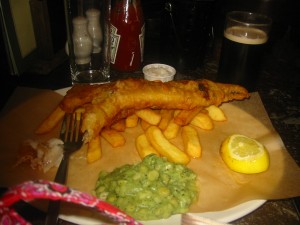 It was actually the best fish and chips I’ve had in the city.
It was actually the best fish and chips I’ve had in the city.
Just when I thought my troubles were over, I was suddenly facing a new dilemma. DO I TIP? Is it offensive if I do? Is it rude if I don’t, especially as they’d taken such good care of me? I paid my bill with exact change and, after that was cleared away, made much of checking my phone while I reached down into my purse to get another pound coin and a piece of paper. I wrote a little note, saying simply: “Thank you!” and placed it and the coin on the table as I got my bag and prepared to go, taking the last sip of Guinness. Unfortunately, my waiter then came over to take my glass and, seeing the note, read it quickly and picked up the tip. My cheeks turned red and I feared I was about to face the biggest monster of English behaviour- the cold shoulder combined with the dislike of money! I needn’t have worried, as it turns out: my waiter looked me straight in the eye and said gratefully “Oh, thank you! That was very nice of you” in an accent that was clearly not British and hinted that he too was a stranger in this strange country where money is considered dirty. Relieved to have not caused offence, I gushed “Oh, well, phew! I’m still trying to learn how all this *gesturing around, indicating the pub* works”
He smiled at me and said “Me too.”
So now the pub is not a location I visit petrified with terror, but I still prefer the peace and quiet of casual drinks with friends or at a restaurant then entering the realm of the pub, laden with social booby-traps as it is.
Tags: 2010 Elizabeth · Pubs
September 19th, 2010 · No Comments
The thing about a city is you always end up missing the country and the thing about the country is you always end up missing the city. This paradox is one of the reasons I’ve been happily tucked away in a suburb for most of my life (I was born in Culver City, but we left Los Angeles before I had turned four)- give me access to the things in the city that I want but with the quiet and amenities only the country can provide.
London, however, has found a better solution to the need for getting away from the city: the plethora of parks and green space that dot the metropolis like a leaky pen on super-absorbent Bounty roll. I don’t understand the psychology of it, but there’s something about having a park, “a bit of earth” as the musical The Secret Garden says, that calms the human mind. Having somewhere to walk your dog, go for a run, bicycle around, take the kids roller-skating, have a picnic, read a book, whatever you wish, somehow relieves the pressures of city life. How the park-goers cope with inclement weather, I’ve yet to observe, but I know just finding “somewhere that’s green” (again, a musical reference – Little Shop of Horrors- I’m just on a roll tonight!) is seemingly vital to the psyche of any Londoner.
I began to feel this pull toward the park myself when I was heading over to visit the Queen’s Gallery at Buckingham Palace. I exited the Tube at the aptly-named Green Park station and discovered myself to be in the midst of an enormous, sprawling park, heavily populated with people (mostly families) spending the day outside and enjoying the weather. Touched by the idyllic scene, I snapped a photo and then starting heading over to the Palace. After turning one or two corners, it was as if I had travelled to a different world instead of only walking further away from the park. The peace and tranquility of the community park was replaced with loud, overexcited tourists, all eagerly clamouring for a photo of the Palace and/or the guards. People continually bumped into me as I tried to get to the Gallery and I had to look around me at all angles to make sure I didn’t step into anyone’s photos.
Viewing the gorgeous art at the Gallery refreshed me slightly but, after fighting my way back through the crowds around the Palace gate’s, I stopped in Green Park to take a breather before heading into the congestion and confinement of the Tube station.
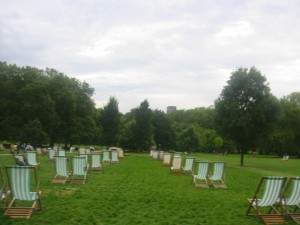 Where to find peace? Green Park!
Where to find peace? Green Park!
A young woman might have once needed a room with a view in Italy, but I began to understand just how much the English need their room and green views [see what I did there?]
Tags: 2010 Elizabeth
September 19th, 2010 · No Comments
As a firm agnostic, I know I visited all the different religious sites (the churches, the mandir, the mosque, and the synagogue) with different feelings and expectations than many of my colleagues. While I found our visits to the non Judeo-Christian places particularly informative, I felt the same apathy during those visits that I felt at the other places of worship. We’ve been told over and over again that Britain is a secular country and, for me, that works out just fine. Understanding this, it should be no surprise that my two favorite buildings to visit were Westminster Abbey and St. Paul’s Cathedral, locations that I have heard many bemoan as having become too much like tourist attractions rather than churches.
I could have happily wandered about Westminster Abbey a whole day (so long as I could avoid the tourists with the bloody audio guides who were walking about like zombies!), visiting the different tombs and reading all the different plaques and memorials. The sheer amount of history in that building is staggering. Despite my lack of religion, walking around the tomb of Queen Elizabeth I was a profoundly moving, almost spiritual, experience. It was if the gap between the past and the present could be breached by the closeness of that past’s remnants.
 Me in front of Westminster Abbey
Me in front of Westminster Abbey
At St. Paul’s, I didn’t feel the tug of history quite as strongly but I was perhaps even more impressed with the artistic aspects of the building, particularly the interiors. Knowing my own limits (stupid asthma), I decided not to ascend the stairs to see the top and, instead, spent a long time looking at the different gorgeous paintings and mosaics, particularly those adorning the ceiling.
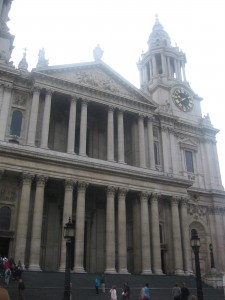 The entrance to St Paul’s.
The entrance to St Paul’s.
Something I noticed at both St. Paul’s and Westminster Abbey was the moment of silence/prayer that occurred during our visits. I applaud this attempt to remind visitors where they were but think it fell flat both times, as many tourists (particularly the children) ignored the announcement and continued on their merry way, many obviously still zoned out and intent on their audio guides. I think that the historic houses of worship in England need to make up their minds one way or another: do they want to remain religious buildings or give over entirely to tourism? This indecision has the buildings in an odd sort of limbo- not entirely sacred, but not secular either.
Tags: 2010 Elizabeth · Churches and Cathedrals
September 19th, 2010 · No Comments
I’m a huge theatre fan (always have been, always will be), so pretty much every moment of spare time I’ve had here that hasn’t been taken up by projects or illness has been spent at the theatre. Many people have already written about individual shows, so I’m going to try and give a comprehensive look at what I’ve seen here in London and where:
–The Merry Wives of Windsor, The Globe Theatre (Southwark/Bankside)
-The 39 Steps, The Criterion Theatre (Piccadilly Circus)
–Bedlam, The Globe Theatre (Southwark/Bankside)
–Aspects of Love, The Menier Chocolate Factory (Southwark)
– Les Miserables (the 25th Anniversary production), The Barbican Centre (Southwark)- TWICE
–Henry IV: Parts One and Two, The Globe Theatre (Southwark/Bankside)
–Passion, The Donmar Warehouse (Covent Garden)
–Wicked, The Apollo Victoria (Westminster)
I’m only going to mention my experiences at the Globe briefly, as I’ve been going to bat constantly in defense of Bedlam and it’s sort of exhausting! I found Merry Wives to be entertaining – it’s not one of my favourite Shakespeare plays, but the cast was fantastic. I saw Bedlam on opening night – its world premiere performance – and I was blown away by it. I wanted to go back and see it again but that didn’t end up working out, though I did pick up a souvenir program and a script on my Henry IV Marathon Day.
Ah, and speaking of Henry! . . . As part of the educational Shakespeare company I interned with for two years, I assistant directed Part One of Henry IV twice, so I was very familiar with the show. I decided to go on a day where I could see both Part One and Part Two which equalled about 8 hours spent in or near the Globe- HEAVEN! I thought the cast of both Parts gave extremely strong performances, particularly Roger Allam as Falstaff and Jamie Parker as Prince Hal. It was also entertaining to see cast members from Bedlam playing different roles, sometimes bit parts really, which made me pay much more attention to them. It was so interesting to see Sam Crane (the foppish Laurence in Bedlam) as Hotspur in Henry or Phil Cheadle, who stole my heart as Doctor Maynard in Bedlam, playing a trio of small roles (Douglas/Davy/Lord Bardolph), or Jason Baughan, the mad doctor in Bedlam, as Westmoreland/Peto, or even seeing Barbara Marten, the neglected wife in Bedlam, as the hillarious Mistress Quickly in Henry. My only complaint about the Henry plays is that I would have liked to see them before Merry Wives, as Merry Wives is the sequel to both Henry IVs and Henry V. Still, knowing the characters and what becomes of Falstaff in Merry Wives made the Henrys all the more enjoyable!
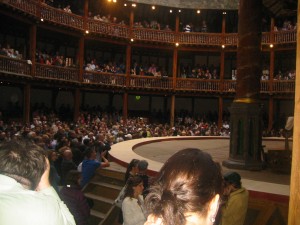 My view of Bedlam (taken during the interval, of course!)
My view of Bedlam (taken during the interval, of course!)
And me at the site of the original Globe.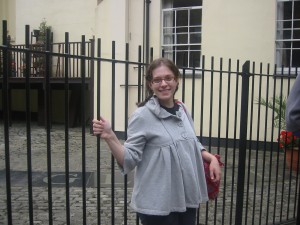
I was pleasantly surprised by The 39 Steps. I didn’t know anything about the play or the cast but, being a film fan, knew that the title at least came from a Hitchcock-type, film noir-ey movie. Imagine my surprise when I discovered it was more spoof than thriller! The Criterion itself was BEAUTIFUL, a gorgeous venue and perfect for such an affectionately-nostalgic play. The UK tour will be hitting Norwich in April, so I’m going to try and go to see if I like it as much with a different cast.
Now. Les Miserables. Bear in mind that I’ve seen Les Miz more times than I would like to admit, have more cast recordings than I’d like to count and in more languages than I should probably tell. This musical was a huge part of my life for about 3 years in high school and had a huge shaping effect on my musical tastes. I didn’t want to see the production at the Queen’s Theatre because it was a bit of “been there, done that”- let me explain to the uninitiated: pretty much all of the musicals Cameron Mackintosh produces (Phantom of the Opera, Cats, Les Miz, Miss Saigon, etc) are brilliant shows but get boxed up and set to be mass produced globally. That basically means, the blocking, lighting, staging, set, costumes, all the onstage “business” will be the same from production to production. That cross Valjean makes downstage left in the middle of Act 2 will be made by every Valjean from Alaska to Hong Kong. That was why, when I heard there was a special, newly restaged version being presented at the Barbican (the original home of Les Miz’s first production) in honour of its 25th Anniversary, I jumped at the chance to go.
To try and express how incredible this production was is beyond me at this point, particularly as I’m tired, sick and sniffly. Suffice it to say, it was MAGICAL. The creative team took a show that I know inside and out, blast its stitches apart and made it something fresh and new, while keeping the same heart, the very core of the show which I fell in love with in the first place. They did away with the annoying rotating stage and used a much more intimate, less intimidating set. New costumes. New orchestrations. New musical cuts. New lighting. I had goosebumps from the sheer awesomeness of it.
Which is why, after getting out of the show Wednesday night (the 15th), I immediately called my partner in crime and fellow Les Miz fanatic, Stephenie, and told her she NEEDED to get tickets. Before I quite knew where I was, we had tickets for the very next night’s performance and were seeing the show together. Seeing the show by myself had been amazing enough but having someone with me who could understand my strange musical-fan language and decipher from just an elbow in the ribs my excitement at the inclusion of a moment from the original novel into the stage production was beyond awesome!
 [At the Barbican. Photo grudgingly taken by Stephenie :D]
[At the Barbican. Photo grudgingly taken by Stephenie :D]
Oh, and we stood at the stage door to get our programs signed. Everyone but the two of us left after Gareth Gates (who played Marius and was, apparently, on the British version of American Idol, or something) had gone, so we were the only ones waiting for Valjean and the other leads- which is VERY STRANGE in the world of Stage Door. We had to call after John Owen Jones (who played Valjean, and is, in my mind, a demi-god) to get him to stop. So, we awkwardly stood at the stage door until 11:30pm (which, no doubt, led to my getting sick) until we decided to head back to the Arran House. We got on the tube at Barbican and decide to transfer to Moorgate so we can take the Northern line to Goodge. Still with me? So we’re walking through the station to get to the right platform and who should pass us? John Owen Jones (Valjean). Yep. And we were the only two at stage door, plus I was wearing my Les Miz shirt and Steph had her program out so we looked like complete stalkers. Did I mention he had left 20 minutes before we did? So how did he end up getting off at Moorgate at the same time? It astounds me . . . . And guess where he was headed? Yes, the Northern Line! He got into the same CAR as we did and Steph and I tried to remain calm and casually take some stealthy stalker photos of him (fail) but he got off at King’s Cross before we could succeed.
Going back a bit further, there is one theatrical experience which I must list as my favourite: Aspects of Love, at the Menier Chocolate Factory. This is one of Andrew Lloyd Webber’s least-well known shows (it is my personal favourite, even above Phantom of the Opera) and it was a miserable failure on Broadway and only played 3 years in London. I knew about the upcoming production before I had even left the States and I was thrilled, as this is the first major production in London since the original. This show is LITERALLY never put on, especially not in the United States (I saw a truly abysmal concert version in Los Angeles my senior year of high school which I’ve tried to erase from my memory). My pet theory on this is that it’s just not a flashy, pretty spectacle-type musical: it’s a deeply moving exploration about the agony of love as told through an incredibly complex story and fantastically beautiful music. To find out more about the show, take a look at: http://en.wikipedia.org/wiki/Aspects_of_love. The Menier is my favourite theatre I’ve visited so far- it is a huge success story, as it operates entirely without any government support and, thereby, is able to produce some truly incredible theatre. It has all the closeness and intimacy of a local community theatre with the talent of a full-scale West End production. Do check out their website: http://www.menierchocolatefactory.com/pages/about_us
The show itself was fantastic- I couldn’t have asked for a better production. To make things even better, I proved that Kate Fox is wrong about the English’s coldness and made friends with the girl working in the box office (whose name- Amanda- it only took me till the interval to find out!) as we mutually geeked out about how much we love the musical. I arrived home on a cloud of musical-induced bliss!
And, most recently, last night I saw Stephen Sondheim’s musical Passion at the Donmar Warehouse (http://www.donmarwarehouse.com/pl111.html) with Stephenie. As with Aspects of Love, this is a show whose music I know extremely well but which is not successful or oft performed because of its intensely emotional, cerebral nature. The Donmar is an incredible theatre – like the Menier, known for its intimate space- and it was the perfect setting for such an emotional complex and poignant piece of music as Passion.
 [Passion logo from: http://3.bp.blogspot.com/_1DZU-LyGw2Q/TFJkwODs5JI/AAAAAAAABLg/F-ss3TaKSSU/s1600/passion.jpg]
[Passion logo from: http://3.bp.blogspot.com/_1DZU-LyGw2Q/TFJkwODs5JI/AAAAAAAABLg/F-ss3TaKSSU/s1600/passion.jpg]
As for the last one on my list, Wicked, it’s a show I’ve seen often in Los Angeles. Stephenie and I (along with some others, I believe) are going Tuesday night before we head out of London. It’s by far the most commercial/touristy of the musicals I will have seen here, but I am looking forward to it nonetheless and am interested in seeing some changes that I believe were made to the show when it came here to London.
If I take away nothing else from this time in London, I’ll have gotten to see some damn good theatre!
Who could ask for anything more?
Tags: 2010 Elizabeth · Theatre
September 19th, 2010 · No Comments
I’ve said this before but I’ll say it again, in case anyone has missed it: I’m a huge Anglophile. If it’s English, it’s pretty much guaranteed that I’ll love it. Coming to the UK has literally been the fulfillment of a lifelong dream. A huge part of why that is lies in the museums it has to offer.
As an English major specialising in 19th Century British Literature and a Medieval & Early Modern Studies Major focusing on Shakespeare and the history of the Tudor dynasty, I’ve been most excited about the museums whose collections have items specifically to do with my areas of interest. These are not always the ones you would think: for example, the British Museum turned out to be somewhat disappointing to me [not to discount its quality or credit at all: I mean, the Rosetta stone was pretty damn cool, as were the Lamassus that I studied in my summer art history course and then got to see in the flesh . . . errr, in the stone?] but the highlight of my visit was the following:
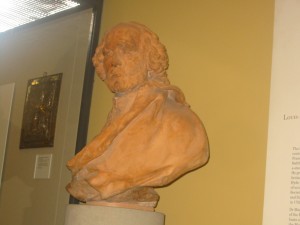
a bust of Shakespeare
and 
Engravings of Henry VIII
[all photos, unless otherwise mentioned are personal]
Disappointing, no? I thought so.
On the other hand, I was magnificently surprised by the museums we visited in Greenwich. Having no interest in science whatsoever, I thoroughly enjoyed walking around the Greenwich Observatory, particularly the Octagonal (?) Room:
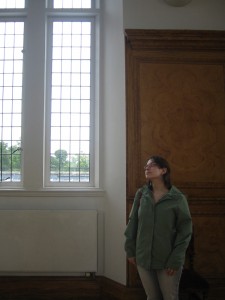 The Queen’s House too was a lovely surprise. Unfortunately, I left my camera in my bag which I checked when we came in, but imagine this scenario:
The Queen’s House too was a lovely surprise. Unfortunately, I left my camera in my bag which I checked when we came in, but imagine this scenario:
Elizabeth has somewhat unwillingly accompanied her friends into the Queen’s House. No sooner does she enter the first gallery but with whom does she come face to face?
 That’s right. My good buddy Henry the Eighth (photo courtesy: http://www.nmm.ac.uk/visit/exhibitions/on-display/the-tudors-at-greenwich-gallery)
That’s right. My good buddy Henry the Eighth (photo courtesy: http://www.nmm.ac.uk/visit/exhibitions/on-display/the-tudors-at-greenwich-gallery)
I enjoyed the Museum of London and the Docklands Museum too but (as I later discovered) because I had picked up some sort of stomach flu, I wasn’t really in the best state of mind to appreciate them fully. I plan to revisit the Museum of London tomorrow – if I’m up to it, for now I’ve got some weird ear, nose and throat infection – and take lots of photos (I had my camera with me when we went as a class, but it decided to die halfway through the Plague presentation). I particularly enjoyed looking at their Vauxhall Gardens presentation and the recreation of Dickens’ London.
I have already expressed my opinions of the National Portrait Gallery elsewhere (http://blogs.dickinson.edu/norwichhumanities/2010/09/national-portrait-gallery-my-two-pence/) but will emphasise again the sheer joy I experienced seeing up close and personal paintings that I’ve looked at in textbooks countless times, particularly this one:
 [Elizabeth I coronation portrait- http://www.npg.org.uk/collections/search/portrait/mw02070/Queen-Elizabeth-I?sText=queen+elizabeth&submitSearchTerm_x=0&submitSearchTerm_y=0&search=ss&OConly=true&firstRun=true&LinkID=mp01452&role=sit&rNo=2)
[Elizabeth I coronation portrait- http://www.npg.org.uk/collections/search/portrait/mw02070/Queen-Elizabeth-I?sText=queen+elizabeth&submitSearchTerm_x=0&submitSearchTerm_y=0&search=ss&OConly=true&firstRun=true&LinkID=mp01452&role=sit&rNo=2)
I’m uncertain whether or not to call our visits to places like Stonehenge, Wesminster Abbey, the Tower of London, or the Roman Baths (in Bath) “museum visits” but, while I had a tremendous time at all of this sites HUGELY significant to my areas of interest, I couldn’t help but notice that they had been “tourist-ized.” Case in point: at the Tower of London, as you look at the stairs where the bones of the two murdered Princes (http://en.wikipedia.org/wiki/Princes_in_the_tower) were supposedly found, you would hear sound effects on a loop which included such gems as “Mother! Where are you?” and “I thought I was supposed to be king.” This made it feel more like Disneyland and the walkthrough of Sleeping Beauty’s Castle than anything else I’ve seen here so far. Also, they look “interactive displays” perhaps a bit too far:
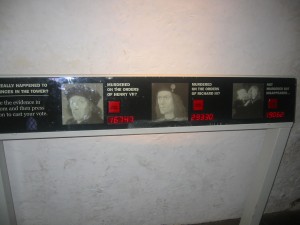 Yes. An electronic counter which allows visitors to vote on who they think murdered the princes. Besides the sheer cheesiness of this attraction, I’m quite irritated to see that Richard III is still getting the rotten end of the stick. Our dear tour guide John agrees with me on this!
Yes. An electronic counter which allows visitors to vote on who they think murdered the princes. Besides the sheer cheesiness of this attraction, I’m quite irritated to see that Richard III is still getting the rotten end of the stick. Our dear tour guide John agrees with me on this!
Beyond the sometimes-unbearably touristy nature of the Tower’s displays, it was still incredible to stand in the buildings where so much history – history that is of particular interest to me – went down.
I’ve gone to quite a few museums by myself as well. Much as I love our group, sometime it’s nice to go at your own pace or go somewhere that not everyone would want to go. Holly and I experienced this in our visit to the Jane Austen Centre in Bath which, for us, having taken English 399 with Professor Moffat on Austen, didn’t really contain anything we didn’t already know (thanks, Moffat!) but was good fun nonetheless:

On one of our free days, I hit two museums I particularly wanted to see: the Tate Britain (NOT the Tate Modern *shudder*) and the Queen’s Gallery at Buckingham Palace.
First of all, I wanted to see the Tate specifically for a portrait of Elizabeth I that I had read was in their collection which, upon visiting, I discovered was either an error on my part or had been taken off display. Nevertheless, I enjoyed wandering around the galleries, particularly when I came across these two pictures, side by side:


On the top, “Ophelia” by Sir John Everett Millais and “The Lady of Shallot” by John William Waterhouse on the bottom.
Both of these paintings are iconic to me and a print of the “Ophelia” adorns the door to my bedroom at home.
As for the Queen’s Gallery, I was thrilled to go for several reasons. First, I wanted to see Buckingham Palace without being a total tourist about it. Second, the current exhibition was entitled Victoria and Albert: Art and Love and I think Victoria and Albert have one of the sweetest love stories in history.

Third and most important, one of the core components of the exhibition was works by Franz Xaver Winterhalter, my ALL TIME FAVOURITE artist, a court portrait painter who painted at least 120 works for Victoria and her family. Again, the special joy here was seeing up close and personal works that I have previously drooled over in textbook or digital format, such as these two :
:
 Victoria and Albert, by Winterhalter.
Victoria and Albert, by Winterhalter.
From the Royal Collection (http://www.royalcollection.org.uk/microsites/vanda/MicroSection.asp?themeid=841)
This is, obviously, not a final account of my museum experiences in London and England as a whole. I fully expect to enjoy more in the next few days (hopefully, if I can get myself feeling better) and many repeat visits over the course of the year.
Tags: 2010 Elizabeth · Museums
September 3rd, 2010 · 2 Comments
Personally, I had been looking forward to going to the NPG ever since we got here- some of my favourite images, absolutely iconic to my field of study are housed here. And I was not disappointed.
People have been going on and on about how the Gallery only had portraits of white, rich men but, strictly speaking, that’s not true. The number of female portraits rivalled, if not exceeded the portraits of the men, certainly not during every era, but overall. As for the other considerations, think about the cost, time and hassle it would have been to get your portrait painted- from the Tudor era to Victorian times (at least) portraits could only be afforded by the wealthy or the important, generally meaning royalty or aristocracy. As we got further on in time, there were more portraits of professionals: important scientists, artists, poets, even some Shakespearean actors! However, these people all had powerful (read: rich) friends or connections and I think a more accurate characteristic of the majority of sitters was celebrity rather than wealth. As has been previously mentioned, there was more diversity in the contemporary (1960s-present) sections of the Gallery but this may not satisfy everyone as many of these were not wholly portraits per se but photographs, sculpture, etc. The sad fact is, now that more people could actually afford painted portraits, the medium is a dying breed. Photography has taken over.
I was having an incredibly difficult time choosing one portrait, as so many of my favourites live in the NPG (indeed, my all time favourite artist Franz Xavier Winterhalter had a few for me to drool over). However, I finally settled on “The Brontë Sisters” painted by Patrick Branwell Brontë (their brother) around 1834. Here is the image’s page from the National Portrait Gallery website:
http://www.npg.org.uk/collections/search/portrait/mw00797/The-Bront-Sisters?LinkID=mp00572&role=sit&rNo=0
and the image itself:
 This is an image that I- as an English major specialising in 19th Century British Literature and a devoted admirer of Jane Eyre, my all-time favourite book- have seen countless times, but there was something completely magical about seeing it in the flesh, as it were. There are many reasons that I love this portrait: it includes Charlotte (who I practically worship), the oft-neglected Anne (whose books I really enjoy and think should be read more), and the bane of my existence Emily (I think Wuthering Heights is probably the worst love story of all time) and shows them in what was really their natural setting: their home. The siblings were very close (several other children had died before their teen years) and I think it’s very significant that the portrait was painted by the only brother, Branwell. Branwell was a very tragic figure: he drank himself to death in 1848, squabbled away his money and talent (both as an artist and a poet) and left his sisters alone to care for their ageing father. I had not really noticed the details of the portrait before: that “pillar” in the middle, which my eyes had frequently just glossed over, appears to actually be a painted-over self-portrait of Branwell. Whether he had just changed his mind about including himself in with his sisters or was simply unhappy with the result is unknown, but there is an eerie symbolism to the ghostly silhouette that remains amidst the figures of the sisters.
This is an image that I- as an English major specialising in 19th Century British Literature and a devoted admirer of Jane Eyre, my all-time favourite book- have seen countless times, but there was something completely magical about seeing it in the flesh, as it were. There are many reasons that I love this portrait: it includes Charlotte (who I practically worship), the oft-neglected Anne (whose books I really enjoy and think should be read more), and the bane of my existence Emily (I think Wuthering Heights is probably the worst love story of all time) and shows them in what was really their natural setting: their home. The siblings were very close (several other children had died before their teen years) and I think it’s very significant that the portrait was painted by the only brother, Branwell. Branwell was a very tragic figure: he drank himself to death in 1848, squabbled away his money and talent (both as an artist and a poet) and left his sisters alone to care for their ageing father. I had not really noticed the details of the portrait before: that “pillar” in the middle, which my eyes had frequently just glossed over, appears to actually be a painted-over self-portrait of Branwell. Whether he had just changed his mind about including himself in with his sisters or was simply unhappy with the result is unknown, but there is an eerie symbolism to the ghostly silhouette that remains amidst the figures of the sisters.
Two months after Branwell’s death, Emily sickened (likely with a fever resulting from a neglected cold) and died very quickly. Anne developed consumption not long after and died within six months of her sister. This left Charlotte the only surviving Bronte sibling until her own death about six years later. It is hard to view the siblings together, apparently happy- approximately 14 years before their tragedies began-and forget this sad fact.
Tags: 2010 Elizabeth
[kml_flashembed movie="http://www.youtube.com/v/0_N3ivscSJg" width="425" height="350" wmode="transparent" /]Photo slideshow with narration: http://www.youtube.com/watch?v=0_N3ivscSJg
We travelled to the Market (located in the borough of Southwark) via the Tube’s northern line, which we exited at Kennington. From there, we proceeded to walk for about 10 minutes through residential neighborhoods until we arrived at the Market, the main entrance of which was announced by a large lettered gate.
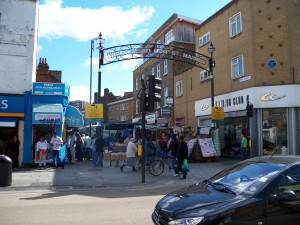
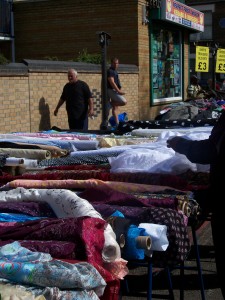
The Market, while not as large as many of the others London has to offer, was unique and vibrant. The majority of the goods were, somewhat unusually, clothing, shoes, accessories and textiles, as well as electronics, cosmetics, Cds & Dvds and other assorted items.
Many of the items were American-themed or American-style clothing or otherwise imported. The small amount of stalls with food were predominantly fruit and veg stands.
The vendors (and many of the customers- presumambly, the residents of the neighborhood) were typically either Jamaican/Afro-Caribbean, Middle Eastern or Eastern European, as well as a small number of Cockneys.
The vendors and customers engaged in an almost perpetual friendly sort of argument with each other: we overheard one conversation between an elderly Cockney vendor and his elderly female Cockney customer. After giving her his prices, he added “Tha’s cheap- betta than th’supermarket” and she replied snarkily “Tha’ ‘taint cheap- tha’s ‘spensive.” We didn’t experience much of the hassling that is typically found at marketplaces: we were pretty much left alone and didn’t hear
any creative vendor’s attempts to bring customers to their wares. However, on our way back were heard slightly more vocal advertisement and, on one memorable instance, a use of Cockney slang-insults to get attention: “1.50, hey, Lady wiff the mustache, over ‘ere!”
After we had covered the whole market (which stretched about 3 blocks) we explored the surrounding area which was mainly residential and consisted largely of low-income estate complexes (immediately recognizable through the tell-tale
sign of laundry lines across the balconies). Again, we mostly encountered people similar to the vendors of the market: largely immigrants or foreigners as well as lower class white Brits. While the neighborhood was relatively well maintained in terms of infrastructure, there were some physical signs of its standing as a lower class area: we found a telephone box with its windows smashed in and its inside completely covered in broken glass and cigarette stubs. In addition to this, many of the buildings were surrounded by barbed wire and a number of walls and fences were in a state of decrepitude. However, the area also contained some nice (but small) parks and at least two handsome churches. We were struck by several banners and posters put up by members of the community, protesting the borough council’s various planned developments to the area, some of which would encroach upon their parks. 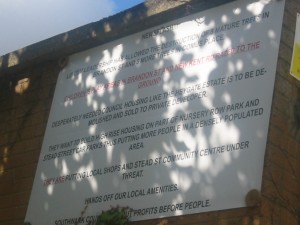
Speaking of religion . . . in the market, we found about 3 Christian bookstands, alongside many self-help books by American preachers. We also noticed a large Muslim population with many women wearing headscarves and other traditional garb. We detected a strong sense of community among the ethnic/religious groups: there were many hairdressers and stores catering exclusively to the Afro-Caribbean women as well as Jamaican DVD/Music stands for the men. There were multiple Halal butchers and restaurants as well as fishmongers.

All in all, the East Street Market and surrounding Southwark clearly exemplify a vibrant, diverse and community-oriented place.
Tags: 2010 Elizabeth · 2010 Patrick · 2010 Sean · Markets
 [Photo: http://www.tobaccoonline.co.uk/images/products/1217200833339AMSobranie-Cocktail-cigarette.png]
[Photo: http://www.tobaccoonline.co.uk/images/products/1217200833339AMSobranie-Cocktail-cigarette.png]
 [From one of the LGBT London support sites: http://www.pinknews.co.uk/images/kulgbt.jpg]
[From one of the LGBT London support sites: http://www.pinknews.co.uk/images/kulgbt.jpg] [Photo from: http://winandwinnow.com/blog/wp-content/uploads/2010/06/win-and-winnow-american-british-english.gif]
[Photo from: http://winandwinnow.com/blog/wp-content/uploads/2010/06/win-and-winnow-american-british-english.gif]












 [Elizabeth I coronation portrait- http://www.npg.org.uk/collections/search/portrait/mw02070/Queen-Elizabeth-I?sText=queen+elizabeth&submitSearchTerm_x=0&submitSearchTerm_y=0&search=ss&OConly=true&firstRun=true&LinkID=mp01452&role=sit&rNo=2)
[Elizabeth I coronation portrait- http://www.npg.org.uk/collections/search/portrait/mw02070/Queen-Elizabeth-I?sText=queen+elizabeth&submitSearchTerm_x=0&submitSearchTerm_y=0&search=ss&OConly=true&firstRun=true&LinkID=mp01452&role=sit&rNo=2)




 :
: Victoria and Albert, by Winterhalter.
Victoria and Albert, by Winterhalter.



